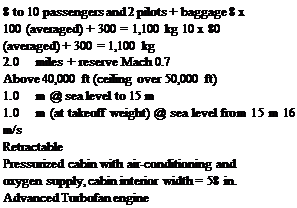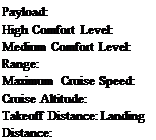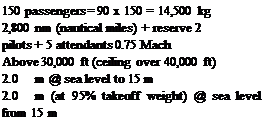Aircraft Specifications and Requirements for Three Civil Aircraft Case Studies
It is recommended that the introductory coursework exercise use one of the three specifications provided as a starting point. Accordingly, the initial follow-up activity is limited to work on the Learjet 45 class aircraft (see the second design specification).
 4 passengers (including pilot) + baggage (e. g.,
4 passengers (including pilot) + baggage (e. g.,
 2 golf bags) = 4 x 85 (averaged) + 60 = 400 kg 800 miles + reserve Above 200 mph
2 golf bags) = 4 x 85 (averaged) + 60 = 400 kg 800 miles + reserve Above 200 mph
Unpressurerized cabin; approximately 10,000 ft (ceiling could be higher)
500 m @ sea level to 35 ft
500 m (at takeoff weight) @ sea level from 50 ft
8 meters per second (m/s)
Retractable
Cabin heating, side-by-side seating, cabin interior width = 50 in.
Conventional Piston engine
DERIVATIVE VERSION AS A LIGHTER TWO-SEATER LIGHT CLUB TRAINER/USAGE aircraft (far 23). (Derivatives are more difficult to develop for smaller aircraft because there is less room with which to work. Fuselage unplugging is difficult unless
the baseline design made provision for it. There are considerable savings in certification cost.)
 2 passengers plus light baggage = 200 kg 400 miles + reserve 140 mph
2 passengers plus light baggage = 200 kg 400 miles + reserve 140 mph
300 m @ sea level to 35 ft 300 m (at takeoff weight) @ sea level from 50 ft 5 m/s Fixed
Cabin heating, side-by-side seating, cabin interior width = 46 in.
(The other specifications are the same as in the baseline four-seater design.)
Derivative versions are achieved by shortening the wing root and empennage tips, unplugging the fuselage section (which is difficult if it is not a continuous section but is possible if the design of the baseline four-passenger aircraft considers this in advance), lightening the structural members, re-engining to lower the power, and so forth.
Design Specifications of a Baseline Eight – to Ten-Passenger (Learjet 45 Class) Aircraft (FAR 25)
 Payload:
Payload:
High Comfort Level:
Medium Comfort Level:
Range:
Maximum Cruise Speed:
Cruise Altitude:
Takeoff Distance:
Landing Distance:
Initial Rate of Climb:
Undercarriage:
Cabin Comfort:
Technology Level: Power Plant:
SHORTENED DERIVATIVE VERSION: FOUR TO SIX PASSENGERS IN A BASELINE AIRCRAFT FAMILY (FAR 25). (This derivative works by unplugging continuous-section fuselage barrel on both sides of the wing.)
 4 to 6 passengers and 2 pilots + baggage 4 x 100 (averaged) + 200 = 600 kg 6 x 80 (averaged) + 120 = 600 kg 2,000 miles + reserve Mach 0.7
4 to 6 passengers and 2 pilots + baggage 4 x 100 (averaged) + 200 = 600 kg 6 x 80 (averaged) + 120 = 600 kg 2,000 miles + reserve Mach 0.7
Above 40,000 ft (ceiling over 50,000 ft)
800 m @ sea level to 15 m
800 m (at takeoff weight) @ sea level from 15 m
(The other specifications are the same as in the baseline design.)
LENGTHENED DERIVATIVE VERSION: TWELVE TO FOURTEEN PASSENGERS IN THE
baseline aircraft family (far 25). (The longer derivative works in the same way by inserting continuous-section fuselage plugs on both sides of the wing.)
Payload: 12 to 14 passengers and 2 pilots + baggage
High Comfort Level: 12 x 100 (averaged) + 300 = 1,500 kg
Medium Comfort Level: 14 x 80 (averaged) + 380 = 1,500 kg
Range: 2,000 miles + reserve
Takeoff Distance: 1,200 m @ sea level to 15 m
Landing Distance: 1,200 m (at takeoff weight) @ sea level from 15 m
(The other specifications are the same as in the baseline design.)
Design Specifications of a Baseline 150-Passenger (Airbus 320 Class) Aircraft (FAR 25)
 Payload:
Payload:
Range:
Crew:
Maximum Cruise Speed:
Cruise Altitude:
Takeoff Distance:
Landing Distance:

![]() 14 m/s Retractable
14 m/s Retractable
Pressurized cabin with air conditioning and oxygen supply, cabin interior diameter = 144 in.
Advanced Turbofan engine
DERIVATIVE VERSION IN THE AIRCRAFT FAMILY (TYPICALLY AIRBUS 319 AND AIRBUS 321 CLASS ON BOTH SIDES OF THE BASELINE AIRBUS 320 AIRCRAFT). This is accomplished by plugging and unplugging the fuselage as in a Bizjet design. Readers are referred to Jane’s All the World’s Aircraft for derivative details and Appendix D for an example. Wide-body aircraft design follows the methodology.
(Note: The author encourages readers to explore market surveys for other classes of aircraft. To diversify, following are brief specifications for two interesting examples [7]).
A. Agriculture Applications Aircraft
1. Airframe must be highly corrosion resistant.
2. Airframe must be easily cleaned (i. e., removable side panels).
3. Airframe must be flushed with water after last flight.
4. Airframe must be easily inspected.
5. Airframe must be easily repaired.
6. Airframe must be highly damage tolerant.
7. Dry and wet chemicals must be loaded easily and quickly.
8. Cockpit must have excellent pilot crash protection.
9. Pilot must have excellent visibility (i. e., flagman, ground crew, and obstacles).
10. The stall speed must be 60 knots or less.
11. The service ceiling is 15,000 ft.
12. Takeoff performance: 20,000-ft field length (rough field) with 50-ft obstacles.
13. Hopper capacity: 400 U. S. gallons/3,200 lbs.
It is suggested that the design be approached through use of FAR Parts 137,135, and 123. Readers may review current designs from Jane’s All the World’s Aircraft. Key considerations include choice of materials, configuration and structural layout, and systems design. In every other respect, the design should follow the standard approach described herein.
B. Airport Adaptive Regional Transport with Secondary Role to Support U. S. Homeland Security (Abridged from [7])
Payload: 49 passengers + flight and cabin crew
Range: 1,500 miles with reserve
Takeoff and Landing 2,500 ft
Field Length:
Maximum Speed: 400 knots
Mission Profile: Multiple takeoffs and landings without refueling
For the airport adaptive role, the aircraft can simultaneously approach a major airport in noninterfering adverse weather and takeoff and land from shorter, largely unused runways, subrunways, and taxiways. The aircraft will be evaluated for an automatic spiral-descending, decelerating approach in instrument meteorological conditions (IMC) (Category 3C) conditions and be able to continue with one engine inoperative. The aircraft also has the following secondary roles:
• Serve the civil reserve fleet and be available during a homeland-security crisis
• Serve as an ambulance
• Serve as transport firefighters to remote wilderness areas
• Serve as an emergency response vehicle for urban terrorism or a natural disaster by changing passenger-accommodation fitment
The aircraft will have half of the payload and a 750-mile range into makeshift landing zones of at least 1,000 ft.
More information is required for the specifications, but the level of technology is not within the scope of this book.
Other than drag estimation and certification regulations (e. g., noise), the SST design is similar to subsonic transport, aircraft design methodology. Supersonic drag estimation is addressed in Chapter 9.











